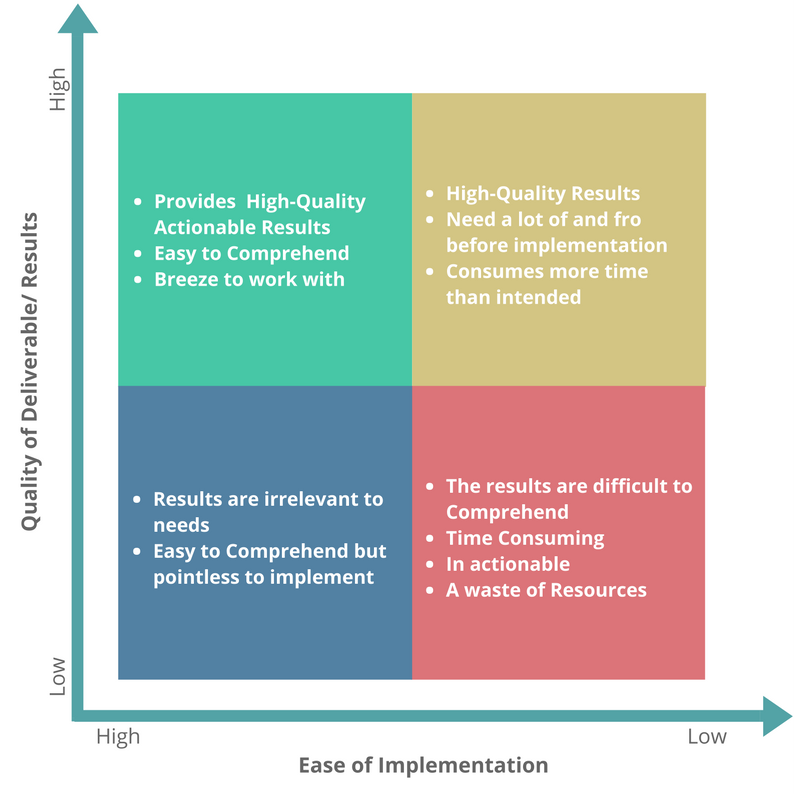Often in business, you need to outsource certain tasks to an external vendor – either a freelancer or firm specialized in your vertical. Coming to the decision that you need to outsource a certain task or process is easy. The difficulty lies in deciding a vendor (Partner?) you should hire for the job.
Further, if the task you want to outsource is something that can affect your relationships with your customers, it becomes vital to select a vendor (potential partner?) that provides the best service. By best I mean a vendor that delivers results best suited to your needs.
And when you go into the market, you find all of them appearing same in terms of their offering. Their sample report looks similar, their website offers similar service, they all communicate well, all say that they offer top quality.
All this put you in a state where decision paralysis exists and it becomes tough to choose the right partner. So how to make a right selection in such a situation?
Based on my 11 years of experience in the service industry, I compiled all the parameters relevant in selecting a vendor in the form of an Outsourcing Decision Matrix. These parameters can help you make an efficient decision while avoiding the decision paralysis altogether. So let’s start:
The Parameters of the Outsourcing Decision Matrix
What Parameters and how do I choose? – you ask.
The Outsourcing Decision Matrix lists parameters in such a way that you can easily classify the vendors into different quadrants based on the traits they exhibit. If you can classify the vendors, you can easily figure out the one that would fit your current needs and can help you achieve your objective.
 Quadrant 1: The vendors that fall into this quadrant offer high-quality results. The results are clear and it takes less time to understand and implement them.
Quadrant 1: The vendors that fall into this quadrant offer high-quality results. The results are clear and it takes less time to understand and implement them.- Quadrant 2: The vendors listed in this quadrant do offer high-quality results; however, implementation of the results consumes a lot of time and energy. The results are not simplified and you will have several follow through questions as to how the results offered cater to or fit your business needs.
- Quadrant 3: Vendors that are listed in this quadrant offer results of low quality and it is easy for you to figure out that the results do not match your needs.
- Quadrant 4: Vendors that belong in this quadrant not only provide low-quality results but working with them wasn’t a good experience for you – to the extent that, you do not wish for anyone to have that kind of experience.
Vendors that fall in Quadrant 1 should be your Go-to vendor, of course.
But there is a question that ponders the mind-
How Do You Define Quality?
When one looks at the Outsourcing Decision Matrix, one question that is often asked is –
The vendors listed here are only those who either provide a high-quality result or a low-quality result. It looks like the vendors who provide medium quality results are not listed here. Why?
The answer is simple – there is no such thing as a medium quality.
A high-quality result is one that you are satisfied with, while a low-quality result is one that is not satisfactory.
In other words, it is a matter of expectation (or) what kind of output you had expected from the service provider. The results that the vendor has offered have either met your expectations or they haven’t. That is- The results either fit your requirement or they don’t. It cannot somewhat fit your requirement.
Let’s understand this with the help of an example:
Let’s say you are looking for a vendor to design business process management software. Below are the four possible scenarios:
- The vendor offers you a solution which – meets your business requirements, is scalable, provides analytical capabilities for measurement of results by tracking metrics and giving quantifiable solutions, is transparent to all stakeholders, integrates well into your existing technical standing and is easy to access and use. This is a high-quality result and is easy to use, falls in the first category.
- The vendor offers you a solution which has very good features for measuring results and conveying client progress. However, in order to install it, you may need to change your current hardware and software set up.
This will fall into the second quadrant as it offers good features but requires that you make changes to your systems. But it does answer your business questions and the features meet your expectations. This doesn’t necessarily mean that the kind of vendor offering this kind of solution won’t work for you. If an upgrade proves profitable in the long run and other processes could also benefit from it, it may be a good choice.
- The vendor offers you a solution that can track metrics but cannot offer a quantitative measure of results. Also, the processes are not transparent to most of the stakeholders. It doesn’t take much time to figure out that this is a low-quality result and this kind of vendor hasn’t met your expectations and falls into the third quadrant.
- The vendor has offered you a solution that is content-centric and integration oriented, while what you needed was a solution that was data-centric and workflow oriented.
On top of it, the vendor requires you to upgrade all your current hardware and software for installation of this software. It is clear that the solution beats your purpose. Not only it fails to meet your expectations, but also is completely deviated from your requirements. Clearly, working with this vendor has been a huge disappointment and a bad experience for you.
The above example clearly illustrates that there is either high quality or low quality- there is nothing else in between.
It must also be understood that the term is defined as per your expectations and the usability you are looking for. Even if the vendor designs software that doesn’t have many features, but this software works well for your business, it is still a high-quality result. Quality entirely depends on your expectations being met or otherwise.
Also, Find Out Whether You are Getting Quality Prior Art Search Services or not here: Attorneys, Are You Getting Quality Search Services?
Implementing the Outsourcing Decision Matrix
A hiring decision can many-a-times be a deal breaker for businesses. A hiring decision in today’s business scenario doesn’t just depend on the cost factor – businesses have moved from the cost curve to the revenue curve.
In other words, a hiring decision cannot just depend on one criterion. There are several factors that come into play. If you are looking at only one factor, you may end up hiring the wrong people which may not be beneficial for your business.
One single factor may have worked in the olden days, but it doesn’t hold good in the current economy which works more on knowledge rather than manual labor. Another very important factor that needs to be considered is the time involved because we live in the era of billable hours in businesses.
The Outsourcing Decision Matrix takes into consideration all these factors into play and can help make an informed decision before hiring.
So next time you’re looking for a vendor (or partner?) to outsource one of your tasks, do refer to the outsourcing decision matrix. It helps take better decisions, each time, every time.
Authored by: Deepak Syal, Director, Operations.
You will definitely love reading this: When looking for an outsourcing vendor, one good criterion of judging them is evaluating their problem-solving skills. Reframing a problem can go a long way in finding solutions, be it for prior art searches or problems incurred in everyday life. Read this article where I have explained why you should look at problems from a different angle – Reframe Problems to find Better Solutions









